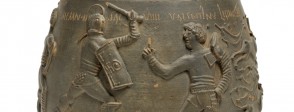The scenes on the vase are vivid and interesting to interpret, so they are the best place to begin. You could look at them together on a whiteboard or print them hardcopy for groups. Look through the three separate scenes and ask what the students think is happening and the details they are using as evidence for their interpretations. Sum up by identifying the three sorts of combat and the two distinct types of gladiator depicted.
Use the interactive game and interactive story in For the classroom to find out more about the different types of gladiator. Discuss their arms and weapons and why setting one type against another, for example, a heavy-armed versus a light-armed, would make for good entertainment for the spectators. Investigate the ways in which people came to be gladiators. Why might someone choose to become a gladiator rather than undergoing some other form of punishment? Find out what sorts of punishments the Romans used and consider again.
Look at the animal mosaic in For the classroom. Ask the students to identify the different animals and how they are being captured. Investigate where this animal hunt is taking place and how they think the animals were transported to the local amphitheatre. How would they have been transported to Rome? Do an internet image search for Piazza Armerina mosaics and you will find other images of animal capture and animals being transported on ships. The animals that appear on the Colchester vase are local to Britain. What impact do the students think exotic animals would have on the audiences in, say, Rome? What would this communicate about Rome and about the man sponsoring the Games?
Use the links in For the classroom to investigate amphitheatres further. Do some map work and locate some or all of the amphitheatres in the list. Look at their shape and design and how this fits with their purpose. Investigate the different parts such as the VIP box, the exits and entrances, how to reach your seats, sunshades, how to protect the spectators from animals and gladiators. Extend the enquiry to other forms of entertainment such as theatre and chariot racing – use the lamp and mosaic in A bigger picture to start you off.
Were the Romans just a bloodthirsty mob?
Use a clip from any gladiator film that represents the Roman audience as a baying mob. Study the critical reaction to the games by Seneca in For the classroom and consider how this differs from the film versions. Ask why people attended the amphitheatre if they disapproved of it. Identify popular contemporary sports and spectacles where contestants face the risk of pain, serious injury or death. Why do the students think people go to watch? Is their willingness to attend any different from that of spectators in the amphitheatre?
What were gladiators for?
This enquiry could start from gladiator fights as a simple source of entertainment for spectators and then move to the question of who paid for the events and their association with political popularity at the civic level of elections and the imperial level of the emperor’s sponsorship. The cost involved in catching and transporting exotic animals might be a good way of raising the question of expense – use the mosaics in For the classroom. You could move on to other forms of entertainment such as theatre and chariot racing and move on to the sponsorship of public buildings. You might make comparisons with contemporary sponsorship and what sponsors want from it.
How Roman was Roman Britain?
Gladiatorial games and amphitheatres are distinctively Roman and a clear indication of the dissemination of Roman culture around the empire. Consider what the presence of an amphitheatre tells us about Romanisation. Take a hard critical view and identify the limits of what this tells us about the depth and breadth of Romanisation. Look at the objects in A bigger picture: how do small finds connected with gladiators such lamps, vases and figures affect that view?
Gladiatorial and other games offer many opportunities for writing, spoken language and making activities. There are many films and novels which can be used to prompt responses. The distinctive open shapes of the amphitheatre and circus lend themselves to population with students’ own versions of fighters and chariots.
Gladiators were a popular subject for Roman graffiti. Use the link in For the classroom to look at examples – notice the names of the fighters. The students could try drawing graffiti in the same style of the fights on the Colchester vase or make up their own.


